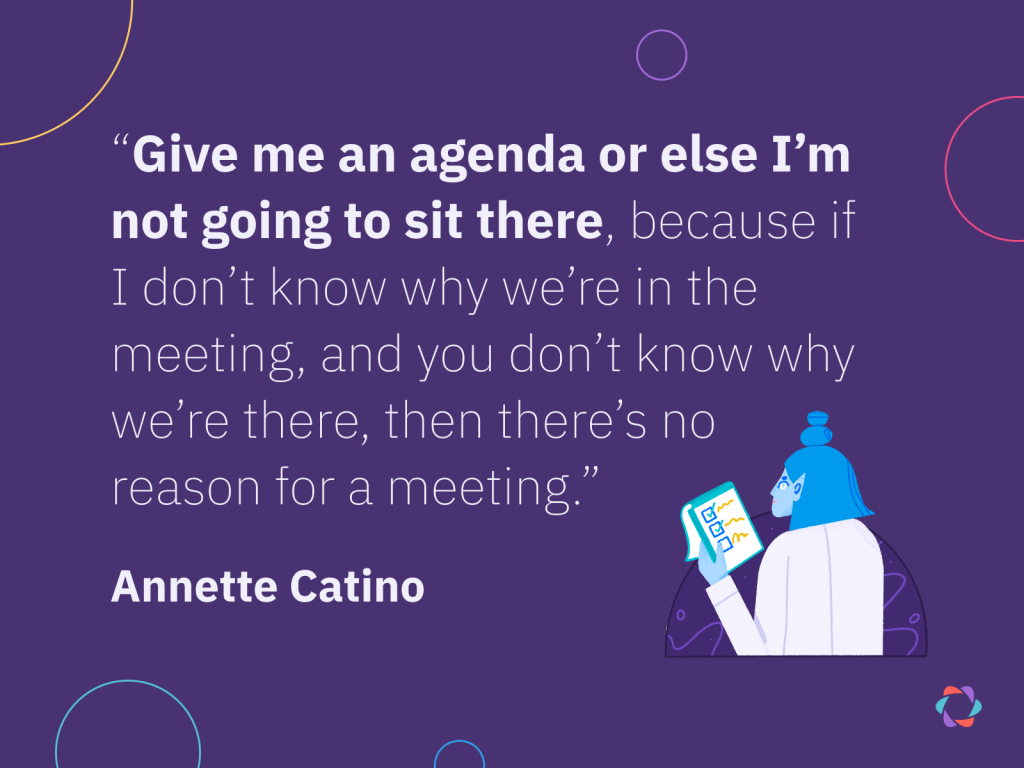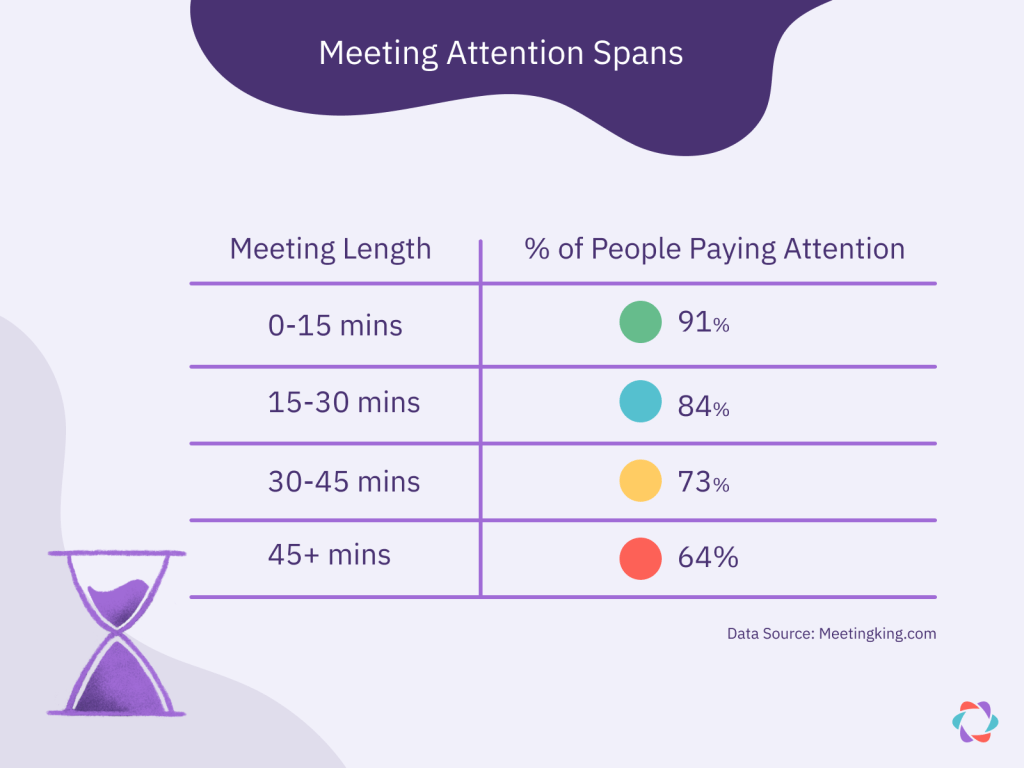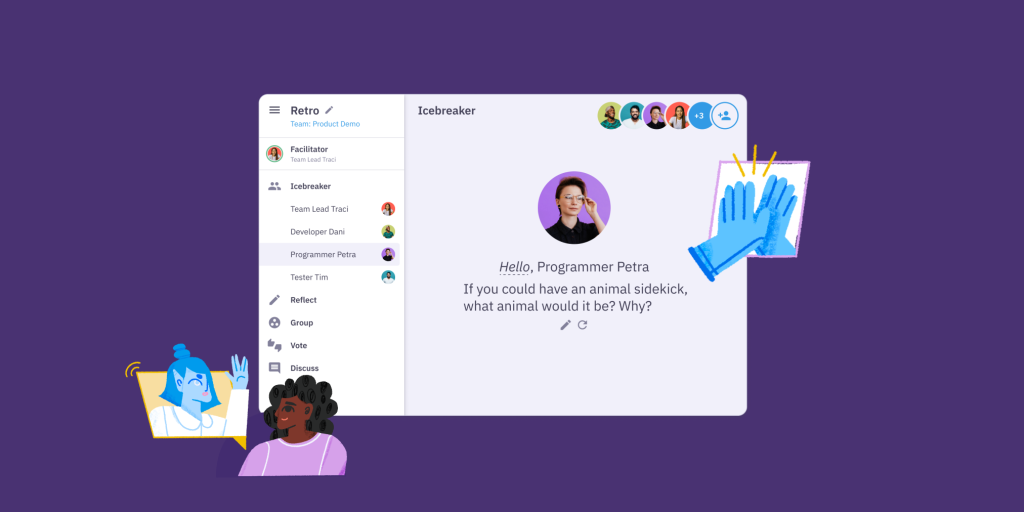29 Effective Meeting Tips for Advanced Facilitators

Timothy Gallwey observes three typical problems with meetings in The Inner Game of Work: They don’t stick to the agenda, they neither start nor end on time, and a few people do most of the talking.
The 29 tips below alleviate these and other problems with meetings, turning them into effective events instead.
We invite you to take these tips and try them out in your team or company to improve your meeting culture.
Meeting preparation tips
First Round Review“Great meetings don’t just happen, they’re meticulously crafted.”
You determine the success of your meeting before it starts. Preparation can’t guarantee a great session, but not preparing guarantees a bad one.
1. Know when to call a meeting
You know the meme, “This meeting should have been an email.” But the inverse is also true: “That email should have been a meeting.”
Face-to-face, synchronous conversation is still the most effective – and appropriate – way to communicate when:
- The topic is sensitive.
- You need to act swiftly
- A meeting reduces the need for heavy documentation.
2. Define the meeting’s purpose
Every meeting should have a goal. That objective informs the agenda, attendees, duration, and outcomes of the gathering.
There are eight possible meeting purposes:
- Planning
- Accountability (e.g., get commitment, drive execution, status check, org. governance)
- Relationship building, maintenance, or restoration
- Personal development (e.g., training, coaching)
- Information gathering and sharing
- Decision-making
- Learning and improvement (e.g., retrospective)
- Problem-solving and idea generation
You want to pick the relevant goals for your meeting from the list above. Then write a concise and clear purpose statement, like:
- “Review Q3 sales results and update Q4 forecast.”
- “Brainstorm solutions for decreasing product sign-ups.”
This gives your meeting a clear focus and a goal to work towards.
3. Consider what happens if you don’t meet
Real-time meetings have real costs, and not just the time each attendee spends in them. They also splinter everyone’s schedule and reduce opportunities for deep work.
So consider your meeting’s goal and ask: “What happens if we don’t meet? Is there another way to achieve our objective?”
Say you want to share information. Can you do that in writing? In a video you record? Even complex goals can be achieved async, like daily standups or retrospectives.
Try making meetings a last resort after exhausting other options.
4. Question the format and frequency
If cutting a meeting is not an option, can you change its frequency? Can you turn daily into weekly or weekly into monthly?
Use the feedback you gather after the meeting to discuss a frequency change with other stakeholders.
You should also scrutinize the meeting’s format. You could do several agenda items asynchronously, giving you more real-time time for other topics.
The “flipped classroom” model is a great example and mental model for meetings. Let people review presentations and other materials in advance. You can then use your time together for discussions, problem-solving, and other collaborative work.
5. Cut length
Make your meetings shorter to make them more effective. Reduce a 60-minute session to half an hour and see how that feels. See what happens when you schedule just 45 minutes for that 90-minute gathering you’ve had on your calendar for ages.
Some meetings do deserve their length, but let each one prove it. Experiment with reducing the duration of existing meetings, and change the default length of any new events from 60 to 30 minutes.
Parkinson’s law says that work or discussions expand to fit the time allotted to them. Use this principle to your advantage.
6. Pick the meeting time carefully
When you hold a meeting may also determine its effectiveness. Consider four factors:
- The day of the week. Mondays, for example, seem good for a weekly planning meeting. But if people need to read a lot of materials in advance, that timing forces them to do so on a Sunday or on the previous Friday.
- The time of day. Most people have energy early in the day. That means mornings might be better for a gathering on a complex question. You can do other routine meetings later in the day.
- The schedule people are on. Makers (like programmers, designers, and writers) need long stretches of uninterrupted time. For them, an event that splits their day is a disaster. Keep this in mind when planning your meetings.
- Time-zones. We live in a globalized world and collaborate with people in different time-zones. Be sure to check that the time is suitable for everyone involved – not just you.
7. Be selective about attendees
Ensure the right people (and only the right people) attend your meeting. Too many participants lead to irrelevant discussions and meetings running over.
But not having a crucial stakeholder present is equally as bad. Then you’ll delay decisions or get them overruled afterward. If in doubt, uninvite.
If you can, don’t invite bosses, managers, and other people with imposing titles when they have nothing to contribute. Their presence usually makes everyone else too self-conscious and insecure to contribute meaningfully to the discussion.
You can allow what Soundcloud dubbed “cameos:” Let others sit in on any meeting. But, they have to bring an interesting piece of information from their team and report back to their teammates on what they learned from your session.
8. Assign everyone a role
Before the meeting starts, everyone should know their role in the gathering.
Giving people a role also helps participants stay focused and be active participants. Here are some of the responsibilities you can assign:
- Facilitator: In charge of the planning, agenda, invitees, and everything else that’s not assigned to another role.
- Note-taker: Takes notes of discussions, decisions, and follow-up actions.
- Time-keeping: Keeps the meeting, agenda items, and speakers on track.
- Speaker or presenter: Someone who owns, talks, or presents a specific agenda item.
- Advisor: Can weigh in on a decision but doesn’t have decision or voting rights.
- Observer: Joins the meeting but can’t participate or contribute.
Being clear about each person’s role also sets expectations for their participation.
9. Sweat your agenda
Have an agenda. Then think carefully about the items you include and how to phrase them.

Holacracy, a method for running organizations through decentralized management, recommends you use just one or two words per agenda item. A Harvard Business Review article on meeting agendas suggests phrasing each item as a question to be answered by the meeting.
There’s no one best approach. It’s worth experimenting with different methods to find what works best for you and your team.
10. Share the agenda beforehand
By sharing the agenda and other materials beforehand, you give everyone (but especially introverts) time to prepare and familiarize themselves with the meeting’s topics.
Few people like to be surprised on the spot, and most prefer some thinking time in advance, especially when it comes to controversial or complex issues.
Meeting facilitation tips
“The show must go on.” That saying from show-business sums up meeting facilitation, too. Once the meeting starts, you must bring it to a successful ending. The following tips help you manage any gathering effectively.
11. Timebox the meeting, agenda, and speakers
A timebox sets a time limit on an activity. If your meetings regularly run over their scheduled time, consider timeboxing the meeting as a whole, the agenda items, or the speakers.
Start with the duration of the meeting. Setting a limit that you monitor throughout the gathering will often be sufficient to stay within its scheduled time.
Divide the meeting time by your number of agenda items. Don’t be afraid to move the meeting forward when the timebox is exceeded. If discussions need more attention take them async.
When that doesn’t work, set a limit on individual agenda items. If that also fails, start timing and limiting each speaker.
12. Keep phones out of sight for a more effective meeting
With every passing year, this rule seems harder to enforce as people get ever more used to having their phones on the ready at all times. However, research shows that just having your phone on the table reduces your ability to think.
No matter how difficult, get people to put away their phones, and your meeting’s effectiveness immediately increases.
13. Don’t jump right in – use an icebreaker
Participants need a chance to settle into the meeting. Their minds have to disconnect from previous calls, events, or projects and then focus on the purpose of this gathering.
Icebreaker questions are a great way to achieve this. Here’s a list of 330 prompts you can use. They also prime everyone to participate by giving everyone a chance to speak and be heard before the agenda begins.
Another effective approach is asking people to recall a recent achievement or happy moment from their personal lives. Doing so can change someone’s negative mindset to a positive one.
14. Remove slide decks
Presentation slides have many disadvantages. A list of bullets can say little while looking somewhat coherent from afar–to both the audience and yourself. Presenters also tend to fill time with unnecessary words and take much longer than their allotted time.
“The reason writing a good 4 page memo is harder than ‘writing’ a 20 page powerpoint is because the narrative structure of a good memo forces better thought and better understanding of what’s more important than what, and how things are related.” – Jeff Bezos, founder Amazon
Replace slide decks with:
- Written memos as Amazon famously does. Give people time before or during the meeting to read the note in full before moving into discussion and decision-making.
- Loom videos as Parabol does. Use your slides to record a short 5-10 minute video overview that people can watch at their own pace, or speed up by 1.25 up to 2x speed.
15. Keep people’s attention
The effectiveness of your meeting largely depends on your ability to keep people’s attention. Here are some ideas for doing so:
- Mix up speaking and text with pictures and videos.
- Ask other attendees for input when you’re the speaker.
- Insert interactive polls and then discuss the results.
- Invite guest speakers to recurring meetings with fixed attendees.
- Avoid running through the same sets of metrics every time.
And most importantly, keep meetings short!

16. Use 1-2-4-All to structure discussions
1-2-4-All is a method to structure group discussions and is part of Liberating Structures, a toolkit for improving collaboration and communication.
1-2-4-All makes a group discussion less messy and more effective by breaking it into four parts:
- 1: One moment alone to reflect.
- 2: A few minutes in pairs to share, compare, improve, or expand on your ideas.
- 4: A few more minutes for foursomes to share and further develop their ideas.
- All: Any team of four can share one idea or question with the whole group.
17. Embrace mild conflict
Various sources“I never learned from a man who agreed with me.”
You don’t want meetings turning into overheated arguments or shouting matches. But, as the above quote suggests, you’re bound to learn little without some disagreement and mild conflict.
Learn to get comfortable with disagreement.
One helpful exercise during arguments is to switch perspectives: let the people who disagree switch roles, asking them to argue for the other’s point of view. This practice helps people reach an agreement or, at least, generates helpful insights to move the discussion along.
18. Have senior folks speak last
The higher up you are in the chain of command, the later you should weigh in on a discussion. If the CEO answers a question first, who will disagree or provide a controversial take on the topic?
You may work in a culture that’s so egalitarian you can contradict more senior folks. Even in those environments, the input of more junior team members is often subconsciously affected by what others say before them.
19. Make preparation mandatory for participation
You shared reading materials well in advance of the meeting. Everyone says they went through them and are ready to discuss the matter. Then one attendee throws out a question that proves they didn’t. What to do?
Often, the one who didn’t prepare hijacks the meeting. They need a briefing on the subject while everyone else waits, incentivizing others to come similarly unprepared next time.
Set a simple rule: if you haven’t prepared for an agenda item, you forfeit your right to contribute. Enforcing this practice is challenging but quickly gets everyone on board with preparation if you do.
20. Interrupt the uninterruptible
One of the hardest aspects of running meetings remains interrupting the uninterruptible folks who unwittingly go off track and take up precious time.
When you facilitate a meeting and find yourself with such an attendee, here’s a helpful tip from a classic Harvard Business Review article that might just do the trick:
“If it is urgent to stop him in full flight, there is a useful device of picking on a phrase (it really doesn’t matter what phrase) as he utters it as an excuse for cutting in and offering it to someone else: ‘Inevitable decline—that’s very interesting. George, do you agree that the decline is inevitable?'”
21. Spot and stop the two types of silences
Silence in meetings is desirable. You should listen to each other and take moments for thought. But be on the lookout for two kinds of silences to break:
- The silence of insecurity. Someone wants to contribute but doesn’t feel authorized or comfortable to do so.
- The silence of opposition. Someone disagrees with someone else, the meeting process, or a topic but doesn’t want to spend their energy fighting it. Therefore, they check out of the meeting.
In both cases, the meeting facilitator – or another participant – should draw the person into the conversation so you can include their perspective in the discussion. Ask them to contribute or take them aside during a break to check if or why they’re disagreeing in silence.
Meeting wrap-up and evaluation tips
The last element to keeping your meetings effective is collecting feedback about them and setting action items. That information helps you decide which events are worth having and which to cut from your schedule.
22. End with clear actions
Use the last part of your meeting to review action items from your conversations.
A clear follow-up is one that:
- Leaves no ambiguity about what to do.
- Has a responsible person assigned to it.
- Includes a due date.
Scrutinize the actions you take out of the meeting. Do they help move the team and project forward? Or do they shelter uncomfortable decisions you’re procrastinating on?
23. Share outcomes and other materials
After your meeting, distribute meeting outcomes such as follow-up actions, memos, notes, and recordings. If possible, share these in public channels with more than just the people who attended.
The higher the level of the gathering, the more chance someone will use their inside knowledge from the meeting for politics. By making the meeting’s content and outcomes transparent, you counter power games and instead create a culture of openness and inclusion.
24. Survey and review your meetings afterward
Ask participants what was valuable to them and what wasn’t, either at the end of the meeting or in a survey.
Create an environment of openness and trust so that people feel comfortable giving feedback. When senior people do so candidly, others will follow. If that’s not the case, you should also send out a feedback survey people can fill out anonymously.
Use the insights you gather this way in Sprint Retrospective meetings. Do this through a dedicated retrospective on meetings or as a fixed retro agenda item, like “Meeting sucks of the month.”
25. Implement the Law of Two Feet
The Law of Two Feet gives you direct and visible feedback on the effectiveness of any meeting. It states:
![Harrison Owen quote on the so-called Law of Two Feet: "If at any time you find yourself in any situation where you are neither learning nor contributing – use you [sic.] two feet and move to some place more to you [sic.] liking. Such a place might be another group, or even outside into the sunshine. No matter what, don’t sit there feeling miserable."](https://www.parabol.co/wp-content/uploads/2022/11/Harrison-Owen-and-the-Law-of-Two-Feet.png?w=1024)
In other words: let people vote with their feet. If they feel a meeting is useless, they can decide not to attend or even leave mid-meeting.
26. Calculate the Return on Meeting (RoM)
Most companies squander meetings as if they’re costless. An hour of four people here, thirty minutes of six people there, an all-hands meeting with dozens of people weekly, and on and on and on.
Every meeting costs money: hundreds, thousands, sometimes tens of thousands of dollars if you calculate the value of each attendee’s time spent in and preparing for meetings.
And yet even a junior person who needs several approvals for a $50 expense can call a meeting with many others without scrutiny.
Keep this cost in mind as you assess your meetings, especially recurring ones.
“This leadership team and the people that reported to them spent an inordinate amount of time each month preparing for and attending what essentially amounted to a glorified update meeting … By the time we got to the restaurant we had a good back-of-the-napkin estimate. The annual cost of the meeting? Close to $3 million. Their minds were blown. ‘We are spending $3 million to have this shitty meeting?!'”
Aaron Dignan in Brave New Work
💡 Pro Tip: try running this live cost calculator during your next session and see if you’re spending time well.
27. Consider a Chief of Staff or executive assistant
As your company grows, organizing meetings gets more complex and time-consuming. Yet some folks – especially scrappy company founders – balk at the notion of hiring an executive assistant or a Chief of Staff.
The math is straightforward: if you and other high-paid staff waste much time planning meetings or attending ones that aren’t useful, a supporting role that makes all meetings efficient pays for itself.
28. Audit your meeting schedule
Despite your best efforts to follow all of the previous tips, your schedule will gradually fill up with more and more meetings. Calendars are like shopping baskets for other peoples’ time, and there are rarely any “spending limits” in place.
Clean up your calendar by doing a monthly or quarterly meeting audit. Review each item on your calendar, and ask what happens if you remove the meeting or lower its frequency. Be bold, try it out, and see what the consequences really are of hitting cancel on an event.
29. Try a free tool that takes the pain out of facilitation
Tools like Parabol help you have an effective meeting by taking the pain out of facilitating. With Parabol, the facilitator can be an active participant in meetings, timebox discussion topics, and ensure action items are documented.

Parabol currently offers free tools for:
“Parabol is kind of like your secretary. It does the legwork for you, so you can focus on the content of the meeting rather than how to run the meeting itself.”
You’re never done making meetings more effective
Follow these 28 tips, and your meetings will become more effective.
But the quest for perfect meetings is never complete. Since they involve people, there are always surprises and changes that require or inspire a new approach.
Here are a few more resources that can help make your meetings more magical:










